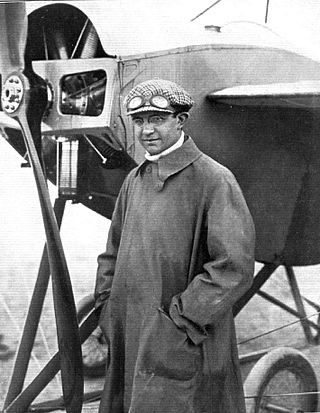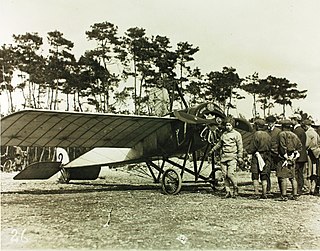
The Coupe d'Aviation Maritime Jacques Schneider, also known as the Schneider Trophy, Schneider Prize or (incorrectly) the Schneider Cup is a trophy that was awarded first annually, and later biennially, to the winner of a race for seaplanes and flying boats. In 1931 Britain met the conditions to retain the Trophy permanently; it was held at the Science Museum in South Kensington, London.

This is a list of aviation-related events from 1912:
This is a list of aviation-related events from 1913:

SPAD was a French aircraft manufacturer active between 1911 and 1921. Its SPAD S.XIII biplane was the most produced French fighter airplane of the First World War.

Édouard de Niéport, usually known as Édouard Nieuport (1875–1911) was the co-founder with his brother Charles of the eponymous Nieuport aircraft manufacturing company, Société Anonyme Des Établissements Nieuport, formed in 1909 at Issy-les-Moulineaux. An engineer and sportsman, Édouard was also one of the pre-eminent aeroplane designers and pilots of the early aviation era . As a pilot, he set a new world speed record of 74.37 miles per hour (119.69 km/h) on 11 May 1911 at Mourmelon, flying his Nieuport II monoplane, powered by a 28 horsepower (21 kW) engine of his own design. Later that year at Châlons, he bettered this time with a new record of 82.73 miles per hour (133.14 km/h). Racing for the Gordon Bennett Trophy in July at Eastchurch, he finished third, beaten for first place by one of his own aircraft, flown by the American pilot C. T. Weymann.

Charles Terres Weymann was a Haitian-born early aeroplane racing pilot and businessman. During World War I he flew for Nieuport as a test pilot and was awarded the rank of Chevalier of the Legion of Honour.
Fabre Hydravion is the name used in English-language sources for an originally unnamed experimental floatplane designed by Henri Fabre. The aircraft is notable as the first to take off from water under its own power.

The Voisin Canard was an aircraft developed by Voisin brothers during 1910 and first flown early in 1911. It was named the Canard because of the resemblance of its forward fuselage to that of a duck's long neck while in flight. It was originally flown as a landplane: with the addition of floats it became one of the first seaplanes used by the French Navy.

The Astra C was a 1912 French single engine biplane, manufactured by Société Astra at Villacoublay. In 1913, the Astra CM Hydro-avion three-seat floatplane version was used to make the world's first scheduled passenger-carrying flights.

Aéroplanes Voisin was a French aircraft manufacturing company established in 1905 by Gabriel Voisin and his brother Charles, and was continued by Gabriel after Charles died in an automobile accident in 1912; the full official company name then became Société Anonyme des Aéroplanes G. Voisin. During World War I, it was a major producer of military aircraft, notably the Voisin III. After the war Gabriel Voisin abandoned the aviation industry, and set up a company to design and produce luxury automobiles, called Avions Voisin.

The Borel Hydro-monoplane was a French seaplane produced in 1912.

The Morane-Saulnier G was a two-seat sport and racing monoplane produced in France before the First World War. It was a development of the racing monoplanes designed by Léon Morane and Raymond Saulnier after leaving Borel and, like its predecessors, was a wire-braced, shoulder-wing monoplane. Construction was of fabric-covered wood throughout, except for the undercarriage struts which were of steel tube.

The Short S.41 was a British single-engined biplane built for the Royal Navy in 1912. Capable of being operated either on wheels or floats, it was successful enough for a further two similar aircraft to be built, with the type remaining in use until the early years of the First World War.

The Nieuport IV was a French-built sporting, training and reconnaissance monoplane of the early 1910s.

The Dunne D.8 of 1912 was a tailless swept wing biplane, designed by J. W. Dunne to have inherent stability. One example was supplied to RAE Farnborough. License-built Burgess-Dunne models were used by the US Signal Corps and United States Navy and the short-lived Canadian Aviation Corps. It was the latter's first and only warplane.

The Gnome 7 Omega is a French seven-cylinder, air-cooled aero engine produced by Gnome et Rhône. It was shown at the Paris Aero Salon held in December 1908 and was first flown in 1909. It was the world's first aviation rotary engine produced in quantity. Its introduction revolutionized the aviation industry and it was used by many early aircraft. It produced 37 kW (50 hp) from its 8 L (490 cu in) engine capacity. A Gnome Omega engine powers the 1912 Blackburn Monoplane, owned and operated by the Shuttleworth Collection, the oldest known airworthy British-designed aeroplane worldwide. A two-row version of the same engine was also produced, known as the Gnome 14 Omega-Omega or Gnome 100 hp. The prototype Omega engine still exists, and is on display at the United States' National Air and Space Museum.

The Gordon Bennett Aviation Trophy is an international airplane racing trophy that was awarded by James Gordon Bennett Jr., the American owner and publisher of the New York Herald newspaper. The trophy is one of three Gordon Bennett awards: Bennett was also the sponsor of an automobile race and a ballooning competition.

The Compagnie générale transaérienne was a predecessor of Air France, founded in 1909. At first it operated airships in France and Switzerland, then added float planes and direct flights from Paris to London. It was the first private company to operate an airplane service. After World War I (1914–18) the company faced mounting competition, and in 1921 it was absorbed by a rival.
The Caudron Type H was a collective name for three different Caudron designs of 1912-3. One of these was an amphibious three seat biplane built for the French military. Two were completed, one appearing at the Paris Aero Salon in November 1912.
The Goupy Hydroaeroplane was a floatplane developed by Ambroise Goupy in 1912, which was displayed at the 1912 Paris Aero Salon. It was described in Flight as being generally comparable to a Goupy biplane designed by Alphonse Tellier displayed the year before, except for the change from wheels to a pair of pontoon-style floats. Janes 1913 stated that at least one had been built in 1912, and that the company was producing around 30 a year, but actual production numbers are not known beyond the 1912 demonstrator. An editorial review of the 1913 Paris Aero Salon bemoaned the lack of advancement in Goupy designs, with no display of a seaplane.


















